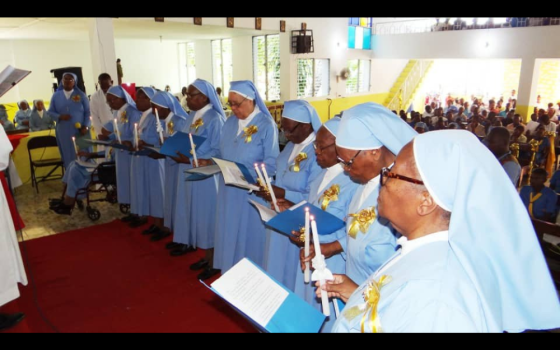
Marching along New York’s Fifth Avenue in the 2009 St. Patrick’s Day Parade, many a Sister and a Daughter of Charity heard onlookers shout: “Thank you for teaching me to read.” “Thank you for giving us our baby.” “Thank you for your compassion.”
Organizers dedicated last year’s parade to the Charity sisters in honor of their 200th anniversary and in recognition of their continuous legacy to the city.
The Sisters of Charity educated generations of New Yorkers; cared for thousands of abandoned children; founded and staffed maternity and pediatric hospitals; and sustained poor women and widows with job placements, day care and with income as wet nurses in the 19th and early 20th centuries.
Such innovative outreach to the poor -- the majority of them Irish famine refugees -- became the hallmarks of the Sisters of Charity and of other religious orders of women. Their enterprises proved a working model for much of New York’s social welfare policies and assistance programs to families, women and children.
But the pioneers of these innovations are not to be found in the pages of the city’s history. Nuns’ work has remained largely invisible or been deemed inconsequential, according to Maureen Fitzgerald, a historian at William and Mary College in Virginia, who has spent more than a decade researching the work of religious women.
 Fitzgerald is the author of the 2006 book Habits of Compassion: Irish Catholic Nuns and the Origins of New York’s Welfare System, 1830-1920, in which she chronicles how the nuns embarked on a host of charitable efforts that resulted in an outgrowth of state-supported services and programs for the city’s disadvantaged, especially its women.
Fitzgerald is the author of the 2006 book Habits of Compassion: Irish Catholic Nuns and the Origins of New York’s Welfare System, 1830-1920, in which she chronicles how the nuns embarked on a host of charitable efforts that resulted in an outgrowth of state-supported services and programs for the city’s disadvantaged, especially its women.
NCR talked with Fitzgerald late last year at the College of Mount St. Vincent, founded by the Sisters of Charity in Riverdale, N.Y., and interviewed her more recently by e-mail.
Though the author focuses on the work of Charity and Mercy sisters, her book also looks at the contributions of numerous other orders that rendered charitable services in the city over decades.
The relative invisibility of sisters in the histories of women and of social welfare extends well beyond the city, to much of America and “frankly, the world,” Fitzgerald said. One reason for the failure to regard the significant role nuns played is that compilers of American women’s history have examined Protestant middle-class and elite women -- after all, it was through their efforts women won the right to vote.
Religious women and their work has to be seen through the prism of anti-Catholic, anti-feminist, anti-Irish and anti-poor attitudes that were fixtures of the cultural hegemony of Protestantism, which prevailed in the 19th and much of the early 20th centuries.
“Historians of women used analytical estimations of women’s power that made sense for Protestant women, but did not adequately measure sisters’ power because it was organized and articulated so differently,” Fitzgerald said. Whatever power nuns wielded rested in their communal work and wealth as single women.
Legally that meant that their property was their own, whereas through the 19th century women who wed lost property rights in marriage. The relative economic autonomy of nuns allowed them to build hospitals, children’s institutions and educational enterprises.
Protestants, Fitzgerald said, had little regard for celibacy. In truth they thought their gender system superior for women, whose liberation was to be found in the home as wives and mothers. In anti-nun and anti-Catholic literature, nuns were depicted as “deluded victims and thereby incapable of understanding their self-interest,” the author wrote in Habits of Compassion.
Reformers were fundamentally at odds with sisters in their views of the poor. Protestants saw pregnancy out of wedlock, prostitution and even poverty itself as shameful conditions, indicative of moral failings that condemned these people to suffer.
They looked upon sisters who cared for such “fallen women” and their offspring as enabling a lifestyle that reformers believed would foster a dependent class. Salvation for the poor, they argued, lay in reforming their lives through temperance and hard work.
In cases of children whose parents were dead, absent or unfit, they would be saved if placed into kind Christian homes in the country. In the mid-19th century, such cultural and religious biases were the engine driving the orphan trains across America, with their cargo of tens of thousands of poor children, Fitzgerald wrote.
In the early years, most of the women becoming nuns were themselves famine victims, arriving in New York with little formal education. Convent life gave them “extraordinary opportunities,” including chances for education and public leadership in charitable and educational work, Fitzgerald said. Classes taught by the nuns and charitable projects run by them served as incubators for the next generation of sisters.
The city’s population of nuns soared from 82 in 1848, to more than 550 by 1865, to 2,846 by 1898.
Among the most inventive achievements of the Sisters of Charity was the New York Foundling Asylum begun in a small house on East 12th Street in Greenwich Village in 1869. Sr. Irene Fitzgibbons commenced the work in response to the plight of babies and young children abandoned on the city’s streets or dropped at one of its horrific public asylums.
Within days of its opening, a woman who had left her baby in a crib on the sisters’ doorstep returned, threatening suicide if she could not stay with her infant. From the moment that Fitzgibbons realized that one could not just save babies, but must attend to the problems women faced when pregnant or trying to raise children, the care of women and children became linked, Fitzgerald said.
Three months after the Foundling opened, the nuns had taken in 120 babies, receiving as many as 12 in a day. Within four years some 1,500 infants were being cared for by outside wet nurses who needed only to present a certificate of health from a physician, and to bring the child each month to the Foundling for supplies and a health checkup.
Fitzgibbons paid each nursing mother 38 cents per day to feed her child and another baby. The money was the sum total of aid the nun received from the state per child. It gave mothers $10 per month -- enough to keep poor families fed and their rents met.
Primarily dependent on city funds, the Foundling Hospital and Asylum’s budget from the city never dipped below $250,000 annually through 1920 and at times neared $500,000.
Still sponsored by the Sisters of Charity, the Foundling is today one of New York’s largest social services agencies for children and families. Perhaps if evidence were needed of nuns still being vanished from the city’s history, it came again last October when The New York Times, reporting on the 140th anniversary of the Foundling, made no mention of the Sisters of Charity who had built it and staffed it for decades.
That the benevolence of Irish and other nuns on the sidewalks and tenements of New York could so greatly influence the state’s discourse on poverty, morality and family life, and its welfare policies, and yet hold no place in its annuls, owes not only to the fact that much social history has resulted from a study of the dominant classes.
Other factors include the nuns’ practice of humility, the fact that they strove to shield poor and “scorned” women from public glare and that they refrained from leaving a paper trail for the archbishops. While this often frustrated Fitzgerald’s efforts to uncover their history, she said, she came to appreciate their reticence. The nuns didn’t lie to bishops, she said, “but they gave the male hierarchy in its entirety the least information possible, pushing to the very line of what they could get away with. And for a long time they got away with a lot.”
[Patricia Lefevere is a longtime contributor to NCR.]
‘Tragic,’ ‘mind-boggling’ investigations
Historian Maureen Fitzgerald holds that the current Vatican visitation and investigation of U.S. women religious has ramifications for all Americans -- not just Catholics. Sisters are among the nation’s primary actors in the field of social justice, and she believes their outreach to the needy is endangered by the current Vatican inquiry.
Nuns have been most involved in developing the mechanisms for the attainment of social justice, said Fitzgerald, a historian who has spent more than a decade researching the charitable work of U.S. sisters. By curbing the power of women religious, the Vatican will also limit the ability of nuns not only to care for the poor, but to advocate on their behalf, she said.
Fitzgerald called Network -- a group of sisters who monitor the effects of public policy on the nation’s impoverished -- “an extraordinary resource for all Americans who seek social justice.” Limiting the power of these sisters to speak and to do their work “seriously undermines the capacity of Catholicism to speak to and for the poor,” she said.
The Leadership Conference of Women Religious, currently subject to a Vatican doctrinal investigation, provides a space for nuns from many orders to speak with other sisters across dioceses and congregations. In so doing the group of sisters wield more power than they could in today’s small and scattered convent settings, she said.
“As a women’s historian, one of the primary marks of women’s relative power we investigate is their ability to construct networks apart from men,” Fitzgerald told NCR. The leadership conference “fills that need,” she noted, but its relative autonomy from ecclesiastical oversight “is clearly seen as a threat to a top-down understanding of male power over women in the church.”
Fitzgerald called it “tragic” and “mind-boggling” that Rome imagines that curbing the autonomy of the leadership conference or what women religious say will restore convent life in America. “The investigation and its consequences will only lead more young women to conclude that entering convent life leaves them vulnerable to the arbitrary dictates of the male hierarchy in ways that threaten their capacity to live out their vocation within the institution of the church,” she said.
-- Patricia Lefevere


